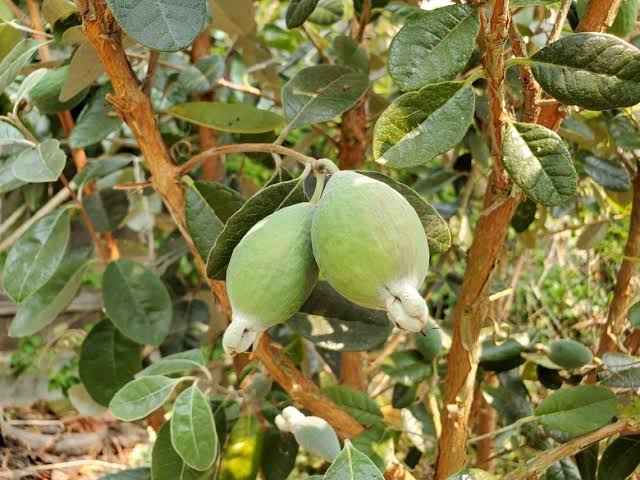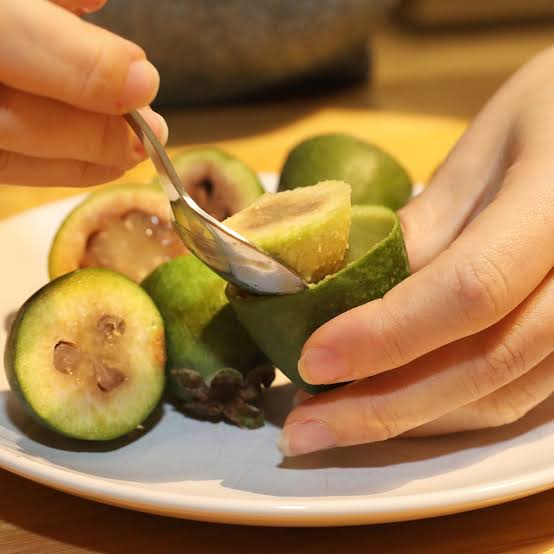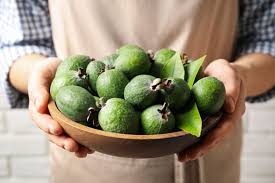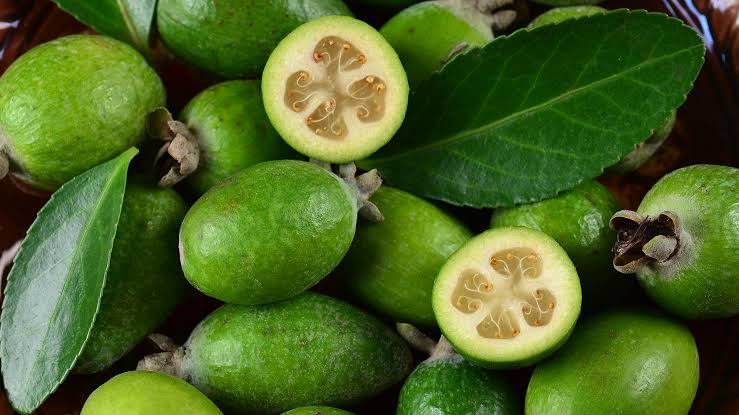Feijoas, scientifically known as Acca sellowiana, are delightful green fruits with a unique taste and a multitude of nutritional benefits. Native to South America, these pear-shaped wonders have found their way into gardens and hearts around the world.
Picture a feijoa – it’s green, about the size of a chicken egg, with a rough, grainy skin. When you cut it open, a fragrant aroma fills the air. The flesh is soft, juicy, and speckled with tiny seeds. One bite, and you experience a flavor that’s a delightful mix of tropical and floral notes, often likened to a blend of guava, pineapple, and mint.
But feijoas are not just a treat for the taste buds; they’re a powerhouse of nutrients. Packed with vitamin C, fiber, and antioxidants, these small green fruits contribute to a healthy and balanced diet. Vitamin C boosts the immune system, fiber aids digestion, and antioxidants help combat oxidative stress in the body.
Growing feijoas can be a rewarding experience. These evergreen shrubs or small trees thrive in subtropical climates but can also adapt to milder regions. They produce beautiful, dark green foliage and, when in bloom, striking red and white flowers that add ornamental value to gardens.
Feijoas are not just about their delicious taste and health benefits – they have cultural significance too. In many South American countries, feijoas are not just a fruit; they are a part of traditions and celebrations. Families gather to harvest and enjoy the fruits, sharing stories and creating lasting memories.
From their unique flavor profile to their nutritional richness and cultural importance, feijoas have rightfully earned their place in gardens and hearts worldwide. So, the next time you bite into a feijoa, savor not just the taste but also the rich story behind this humble yet extraordinary fruit.
Read Also: Guide to Milk Production, Composition, and Nutritional Value of Milk
The History of Feijoas

The history of feijoas, scientifically known as Acca sellowiana, traces back to their native lands in South America. Indigenous to regions such as Brazil, Uruguay, and Argentina, these green gems have a rich cultural and historical significance.
Feijoas have a long history of cultivation by native communities in South America, where they were valued not only for their unique taste but also for their medicinal properties. The fruit was used to treat various ailments, showcasing the traditional knowledge and wisdom of the indigenous people.
In the 19th century, German botanist Moritz Alphons and French botanist Auguste Pyramus de Candolle officially classified and named the feijoa plant after João da Silva Feijó, a Portuguese naturalist. This marked the beginning of its formal recognition in the botanical world.
As time passed, feijoas began to capture the interest of horticulturists and garden enthusiasts, leading to their introduction to different parts of the world. The fruit’s adaptability to various climates and its ornamental qualities contributed to its spread, finding homes in gardens as far as New Zealand, Australia, and parts of Europe.
In New Zealand, feijoas gained popularity in the mid-20th century, becoming a beloved backyard fruit. The climate proved favorable for their cultivation, and the fruit thrived in the island nation. Today, New Zealand is one of the leading producers of feijoas globally.
Feijoas have become more than just a fruit; they embody a connection between cultures and a shared appreciation for their delightful flavor. Whether enjoyed fresh, in culinary creations, or as part of cultural celebrations, the history of feijoas continues to unfold, leaving a lasting legacy in gardens and on plates around the world.
The Nutritional Values of Feijoas

Feijoas, scientifically known as Acca sellowiana, are not just tasty; they also offer a bounty of nutritional benefits. These green wonders are packed with essential nutrients that contribute to a healthy and balanced diet.
Firstly, feijoas are an excellent source of vitamin C, an essential antioxidant that supports the immune system and helps the body fight off infections. Just a single feijoa can provide a significant portion of your daily vitamin C needs, making it a delicious way to boost your overall health.
In addition to vitamin C, feijoas are rich in dietary fiber. Fiber is crucial for digestive health, promoting regular bowel movements and preventing constipation. Including feijoas in your diet can contribute to a well-functioning digestive system and help maintain a healthy weight.
Feijoas also contain various minerals such as potassium, magnesium, and copper. Potassium is essential for maintaining proper heart and muscle function, while magnesium plays a role in bone health and muscle function. Copper, although needed in smaller amounts, is important for overall well-being.
These green gems are low in calories, making them a guilt-free snack option. Whether you enjoy them fresh, add them to salads, or use them in smoothies, feijoas provide a burst of flavor without compromising your calorie intake.
From immune-boosting vitamin C to digestion-friendly fiber and a range of essential minerals, these fruits offer a delectable way to nourish your body and indulge in a healthy treat. So, the next time you savor a feijoa, know that you’re not just enjoying a delightful taste but also reaping the nutritional rewards it brings.
Read Also: Understanding Milk Quality and Quality Characteristics of Milk
Health Benefits of Feijoas

Feijoas, scientifically known as Acca sellowiana, come with a host of health benefits, making them a delightful addition to a well-rounded diet.
1. Rich in Vitamin C: Feijoas are a potent source of vitamin C, a crucial antioxidant that supports the immune system. Regular consumption may help boost your body’s ability to ward off illnesses and infections.
2. Dietary Fiber for Digestive Health: These green wonders are high in dietary fiber, aiding in digestion and promoting a healthy digestive system. Fiber helps prevent constipation and supports overall gut health.
3. Low-Calorie Nutrient Boost: Feijoas are low in calories but high in nutritional value, making them a guilt-free snack option. They offer a satisfyingly sweet taste without contributing significantly to calorie intake.
4. Minerals for Vital Functions: Feijoas contain essential minerals like potassium, magnesium, and copper. Potassium supports heart health and helps regulate blood pressure, magnesium is vital for muscle and bone health, and copper plays a role in various bodily functions.
5. Antioxidant Properties: The presence of antioxidants in feijoas helps combat oxidative stress in the body. Antioxidants are essential for neutralizing free radicals, potentially reducing the risk of chronic diseases.
6. Hydration: Feijoas have a high water content, contributing to hydration. Staying adequately hydrated is essential for overall health, aiding in various bodily functions and promoting skin health.
7. Versatile Culinary Use: Incorporating feijoas into your diet can add variety to your meals. Whether enjoyed fresh, added to salads, blended into smoothies, or used in cooking and baking, feijoas provide a tasty and nutritious element to your culinary creations.
Feijoas offer a range of health benefits, from immune support to digestive wellness and beyond. Including these green gems in your diet not only enhances your taste experience but also contributes positively to your overall well-being.
How to Grow Feijoas
Growing feijoas, scientifically known as Acca sellowiana, can be a rewarding experience, bringing forth a bounty of delicious fruits. Here’s a simple guide to help you cultivate these green wonders:
1. Climate and Soil: Feijoas thrive in subtropical to mild temperate climates. They prefer well-draining soil with a slightly acidic to neutral pH. Ensure the planting site receives full sunlight for optimal growth.
2. Planting: Plant feijoas in the spring or early fall when the soil is warm. Space multiple plants about 10 feet apart to allow sufficient room for growth. Dig a hole slightly larger than the root ball, and plant the feijoa at the same depth it was in its container.
3. Watering: Provide consistent watering, especially during dry spells. Feijoas prefer moist soil but are also tolerant of short periods of drought.
4. Mulching: Mulch around the base of the plant to retain moisture, suppress weeds, and regulate soil temperature.
5. Pruning: Regular pruning helps shape the feijoa plant, encourages airflow, and enhances fruit production. Prune in late winter or early spring before new growth begins.
6. Fertilizing: Feijoas benefit from a balanced fertilizer in spring and early summer. Use a fertilizer with a higher potassium content to encourage fruit development.
7. Pollination: Feijoas are not self-pollinating, so it’s beneficial to plant at least two trees for cross-pollination. Bees and other pollinators play a crucial role in the feijoa pollination process.
8. Harvesting: Harvest feijoas when they are fully ripe, typically in autumn. The fruits should yield slightly to gentle pressure when ripe.
You can pick fallen fruits and use them as they continue to ripen off the tree.
9. Pests and Diseases: Keep an eye out for common pests such as aphids or scale insects. Regularly inspect the plant for signs of disease and treat promptly if detected.
10. Enjoying the Fruits: Once harvested, feijoas can be enjoyed fresh, added to fruit salads, used in desserts, or blended into smoothies. The possibilities are endless!
Read Also: Importance of Personal Hygiene and How to Improve on it

